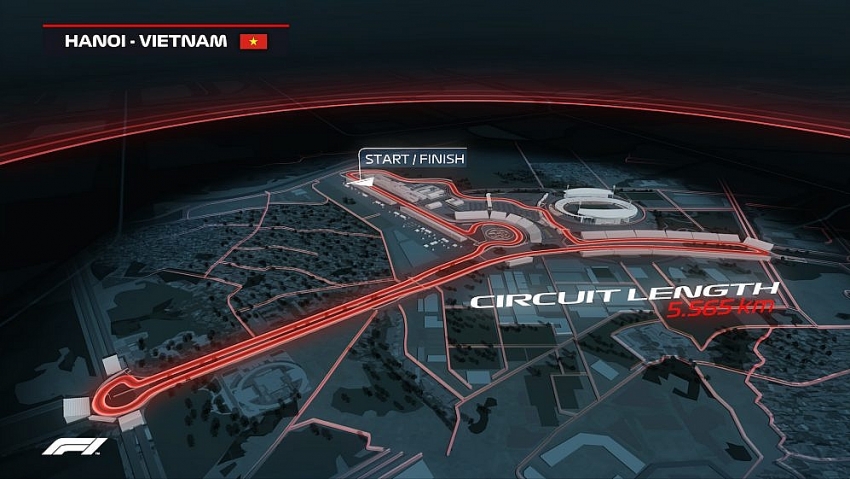Hanoi rushes to build F1 racing circuit
 |
| The design of the F1 racetrack in Hanoi |
Chairman of Hanoi People's Committee Nguyen Duc Chung has recently approved the 1:500 scale detailed planning of the F1 Vietnam Grand Prix Hanoi. Accordingly, the area under study for detailed planning belongs to South Tu Liem district’s wards My Dinh 1, My Dinh 2, Me Tri, and Phu Do.
The more than 5.5 kilometres long F1 street racing circuit includes an operating centre and stands alongside 22 challenging turns inspired by renowned tracks around the world, such as Suzuka’s S-Curves (Japan) or Nurburgring (Germany).
Specifically, to the east of the racetrack is Le Quang Dao Street (adjacent to My Dinh Water Sports Stadium, Vietnam Youth Football Training Centre, and Vietnam-China Friendship Palace); the northwest border neighbours the Hanoi High-Level Athletes Training Centre, Tan My Street, and the football training grounds; the southwest side is close to Nhue River; and the southern border will lie alongside Phu Do residential area and Phu Do market.
Hanoi is rushing to build the F1 race track on the total planned land area of 88.09 hectares, which will be divided into two main areas.
In particular, the Hanoi People's Committee advocates maintaining the existing functional area, including My Dinh National Stadium and its square, Golf Academy, and Tu Liem Post Office. This area will be used to organise events and to build assembly stands and auxiliary racetracks.
A new functional area to be built includes racetracks, an operating centre, stands, public areas, support areas, events area, a three-storey pit building, a racetrack overpass, broadcasting centre, storage centre, medical centre, warehouse, car park for race teams, and helicopter parking lots.
According to the approved planning, the racetracks will be 12-15 metres wide, mainly running on the current road area with a length of about 4km. The roads of Le Duc Tho, Le Quang Dao, Ho Tung Mau, and Thang Long Avenue will be upgraded to meet the technical standards of F1 tracks. The remaining 1.5km of racetracks will be newly constructed.
The design of the Grand Prix Hanoi racetrack was inspired by The Imperial Citadel of Thang Long, ensuring modern architecture while respecting the original spatial organisation and landscape of the national sports complex of My Dinh.
Also in the detailed planning, the circuit will still be used as a regular road after the completion of the race.
The F1 race is expected to land in Hanoi in April 2020, hoping to widely promote the image of the country, which is also the third Southeast Asian country to host a Grand Prix and the second country after Singapore to hold the race in 2020.
What the stars mean:
★ Poor ★ ★ Promising ★★★ Good ★★★★ Very good ★★★★★ Exceptional
 Tag:
Tag:
Related Contents
Latest News
More News
- Free tickets, Lunar New Year promotions on offer at Vietjet Mega Livestream (November 26, 2025 | 15:32)
- UNIQLO unveils upgraded heat-retention wear at Hanoi event (October 26, 2025 | 10:00)
- Vietnam named among world’s top four culinary destinations (October 24, 2025 | 17:09)
- Vietnam and Denmark strengthen dialogue on sustainable fashion (October 20, 2025 | 09:11)
- Fusion rolls out special initiatives to celebrate Vietnamese Women’s Day (October 17, 2025 | 20:00)
- Showcase AC 2025 set to light up Hanoi stage (September 12, 2025 | 18:06)
- Hotel Indigo Saigon The City hosts event to reimagine city’s beloved alleyways (July 23, 2025 | 17:04)
- UNIQLO’s sustainability strategy behind the brand's global growth (June 23, 2025 | 15:42)
- Vietnam International Travel Mart 2025 kicks-off in Hanoi (April 10, 2025 | 17:50)
- Phu Quoc named as one of Asia's 'Best Islands' (March 13, 2025 | 10:24)





























 Mobile Version
Mobile Version